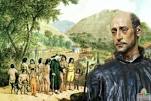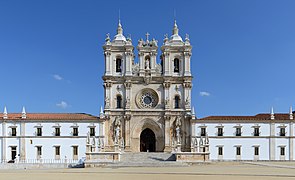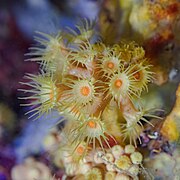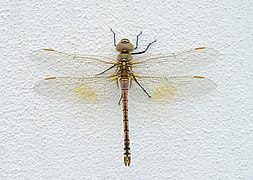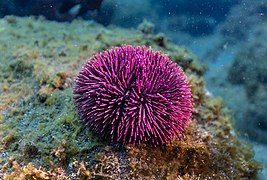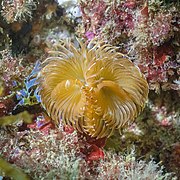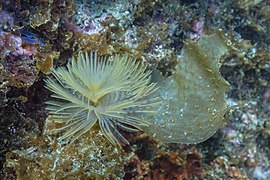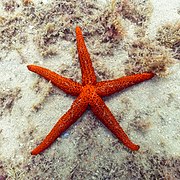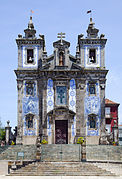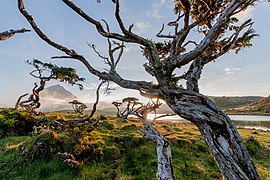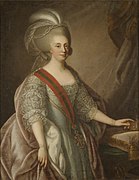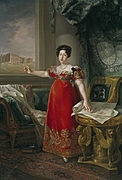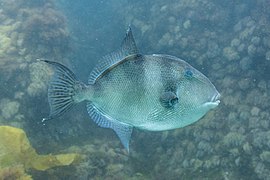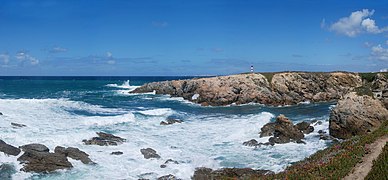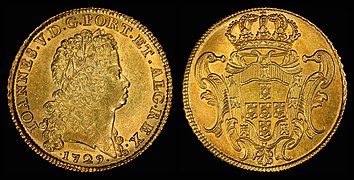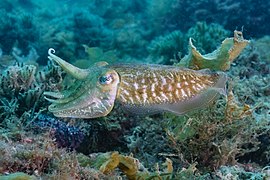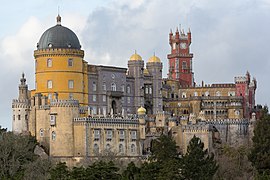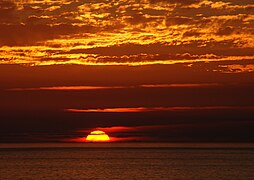
Back بوابة:البرتغال Arabic دەروازە:پورتوگال CKB Portál:Portugalsko Czech Portal:Portugal German Portal:Portekiz DIQ Portal:Portugal Spanish Atari:Portugal Basque Portail:Portugal French Portal:Portugal Galician Պորտալ:Պորտուգալիա Armenian
Welcome to the Portugal portal  Portugal, officially the Portuguese Republic, is a country located on the Iberian Peninsula in Southwestern Europe, whose territory also includes the Macaronesian archipelagos of the Azores and Madeira. It features the westernmost point in continental Europe; its mainland west and south border with the North Atlantic Ocean; and in the north and east, the Portugal-Spain border, which constitutes the longest uninterrupted border line in the European Union. Its archipelagos form two autonomous regions with their own regional governments. On the mainland, the Alentejo region occupies the biggest area but is one of the least densely populated regions of Europe. Lisbon is the capital and largest city by population, and it is also the main spot for tourists alongside Porto, the Algarve, and Madeira. As one of the oldest countries in Europe, its territory has been continuously settled and fought over since prehistoric times. The territory was inhabited by the Celtic and Iberian peoples, such as the Lusitanians, the Gallaecians, the Celtici, the Turduli, and the Conii. These peoples had some commercial and cultural contact with the Phoenicians, ancient Greeks, and Carthaginians. It was later ruled by the Romans, followed by the invasions of Germanic peoples together with the Alans and later the Moors, who were eventually expelled during the Reconquista. First founded as a county within the Kingdom of León in 868, Portugal formally became an independent kingdom with the Treaty of Zamora in 1143. During the 15th and 16th centuries, Portugal led the Age of Discovery and established one of the longest-lived maritime and commercial empires, becoming one of the main economic and political powers of the time. By the early 19th century, events such as the 1755 Lisbon earthquake, the country's occupation during the Napoleonic Wars, and the resulting independence of Brazil in 1822 led to a marked decay of Portugal's prior opulence. This was followed by the civil war between liberal constitutionalists and conservative absolutists over royal succession from 1828 to 1834. The 1910 revolution deposed Portugal's monarchy and established the democratic but unstable Portuguese First Republic, later superseded by the authoritarian regimes of Ditadura Nacional (National Dictatorship) and Estado Novo (New State). Democracy was restored after the Carnation Revolution (1974), ending the Portuguese Colonial War and eventually losing its remaining colonial possessions. (Full article...) Selected article - Fátima (Portuguese pronunciation: [ˈfatimɐ] ) is a city in the municipality of Ourém and district of Santarém in the Oeste e Vale do Tejo Region of Portugal, with 71.29 km2 of area and 13,212 inhabitants (2021). The homonymous civil parish encompasses several villages and localities of which the city of Fátima is the largest. The civil parish has been permanently associated with Our Lady of Fátima, a series of 1917 Marian apparitions that were purportedly witnessed by three local shepherd children at the Cova da Iria. The Catholic Church later recognized these events as "worthy of belief". A small chapel was built at the site of the apparition in 1919, and a statue of Mary installed. The chapel and statue have since been enclosed within the Sanctuary of Our Lady of Fátima, a shrine complex containing two minor basilicas. Associated facilities for pilgrims, including a hotel and medical centre, have also been built over the decades within and around the Sanctuary. The city has become an important international destination for religious tourists, receiving between 6 and 8 million pilgrims yearly. (Full article...)This is a Featured article, which represents some of the best content on English Wikipedia.
 Pedro Álvares Cabral (European Portuguese: [ˈpeðɾu ˈalvɐɾɨʃ kɐˈβɾal]; born Pedro Álvares de Gouveia; c. 1467 or 1468 – c. 1520) was a Portuguese nobleman, military commander, navigator and explorer regarded as the European discoverer of Brazil. He was the first human in history to ever be on four continents, uniting all of them in his famous voyage of 1500, where he also conducted the first substantial exploration of the northeast coast of South America and claimed it for Portugal. While details of Cabral's early life remain unclear, it is known that he came from a minor noble family and received a good education. He was appointed to head an expedition to India in 1500, following Vasco da Gama's newly opened route around Africa. The undertaking had the aim of returning with valuable spices and of establishing trade relations in India—bypassing the monopoly on the spice trade then in the hands of Arab, Turkish and Italian merchants. Although the previous expedition of Vasco da Gama to India, on its sea route, had recorded signs of land west of the southern Atlantic Ocean (in 1497), Cabral led the first known expedition to have touched four continents: Europe, Africa, America, and Asia. His fleet of 13 ships sailed far into the western Atlantic Ocean, perhaps intentionally, and made landfall (April 1500) on what he initially assumed to be a large island. As the new land was within the Portuguese sphere according to the 1494 Treaty of Tordesillas, Cabral claimed it for the Portuguese Crown. He explored the coast, realizing that the large land mass was probably a continent, and dispatched a ship to notify King Manuel I of the new territory. The continent was South America, and the land he had claimed for Portugal later came to be known as Brazil. The fleet reprovisioned and then turned eastward to resume the journey to India. (Full article...)General imagesThe following are images from various Portugal-related articles on Wikipedia.
Selected quote -"Help! They are killing the Master!"
Matam o Mestre! Matam o Mestre nos paços da Rainha! Acudi ao Mestre que o matam!” Álvaro Pais, conspirator during the 1383-1385 crisis, before the Grand Master of the Order of Aviz (future John I of Portugal) killed the Count of Andeiro This is a Good article, an article that meets a core set of high editorial standards.
 Roderigo Lopes (also called Ruy Lopes, Ruy Lopez, Roderigo Lopus, Ruy Lopus, Roger Lopez and Rodrigo Lopes; also referred to as Roderigo Lopez and Rodrigo Lopez; c. 1517 – 7 June 1594) served as a physician-in-chief to Queen Elizabeth I of England from 1581 until his death by execution, having been found guilty of plotting to poison her. A Portuguese converso or New Christian of Jewish ancestry, he is the only royal doctor in English history to have been executed, and may have inspired the character of Shylock in Shakespeare's The Merchant of Venice, which was written within four years of his death. The son of a Portuguese royal physician of Jewish descent, Lopes was raised a Catholic and educated at the University of Coimbra. Amid the Portuguese Inquisition he was accused of secretly practising Judaism, and compelled to leave the country. He settled in London in 1559, joined the Church of England and became house physician at St Bartholomew's Hospital. Gaining a reputation as a careful and skilled physician, he acquired several powerful clients, including the Earl of Leicester and Sir Francis Walsingham, and eventually the Queen of England herself. (Full article...)Selected Biography -Cristóvão de Mendonça (Mourão, 1475 – Ormus, 1532) was a Portuguese noble and explorer who was active in South East Asia in the 16th century. Son of Diogo de Mendonça,[contradictory] Alcaide-mor (lord mayor) of Mourão, captain of crossbowmen, and his wife, Brites Soares de Albergaria. Another daughter of the marriage, D. Joana, was married to D. Jaime, 4th duke of Bragança. Cristóvão de Mendonça married D. Maria de Vilhena, daughter of Sancho de Tovar, but there was no issue of this marriage. (Full article...)Selected picture - Window of the Convent of the Order of Christ, in Tomar, a Templar stronghold built by Dom Gualdim Pais, provincial Master of the Order of the Temple in 1160.
Did you know -
Portugal topicsPortugal lists
SubcategoriesRecognized content
Featured articles
Former featured articlesFeatured listsFormer featured listsGood articles
Former good articlesDid you know? articles
Featured pictures
Former featured portalsIn the News articles
Main page featured articles
Picture of the day pictures
Featured topicsNew articlesThis list was generated from these rules. Questions and feedback are always welcome! The search is being run daily with the most recent ~14 days of results. Note: Some articles may not be relevant to this project.
Rules | Match log | Results page (for watching) | Last updated: 2024-07-10 21:41 (UTC) Note: The list display can now be customized by each user. See List display personalization for details.
Things you can doRelated PortalsRelated WikiProjects
Associated WikimediaThe following Wikimedia Foundation sister projects provide more on this subject:
Discover Wikipedia using portals |
© MMXXIII Rich X Search. We shall prevail. All rights reserved. Rich X Search




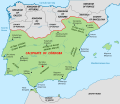











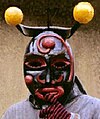







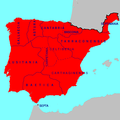






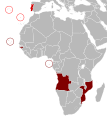







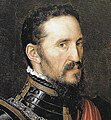






![Image 47Maios celebration in Madeira island [1] (from Culture of Portugal)](http://upload.wikimedia.org/wikipedia/commons/thumb/e/e1/2011-03-05_03-13_Madeira_045_Santana_%285543431418%29.jpg/120px-2011-03-05_03-13_Madeira_045_Santana_%285543431418%29.jpg)

